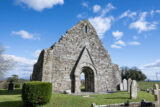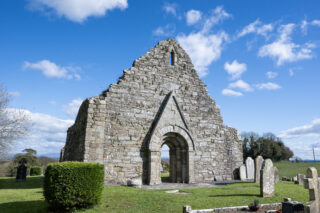Fógra
WARNING: It should be noted that these sites are unguided and a level of care and caution should be maintained during all stages of your visit. The Office Of Public Works (OPW) will not be held responsible for any damages, injuries, or losses that occur
Killeshin Church
The surviving structure of Killeshin Church, located in County Laois, is a notable example of 12th century Romanesque architecture. The church features a western doorway that is widely regarded as one of the finest representations of Romanesque art in Ireland. This doorway comprises four receding arches, each intricately carved with a variety of patterns. Notably, the second arch is adorned with depictions of animals and birds, while the keystone of the outer arch prominently displays a human head in relief, characterized by a moustache and beard styled in uniquely curled locks. Each of the eight supporting pillars is topped with a distinct human head, exhibiting a range of expressions; some are clean-shaven, while others sport twisted moustaches and curled beards, with their hair intertwined with serpentine forms. Two inscriptions are carved into the doorway: one on the north side reads, "A prayer for Diarmait, King of Leinster," and the other commemorates Cellachan, who may have been a master stonemason or artist associated with the site.
The chancel of the church, presumed to have been constructed after the nave and doorway, features an original east window that has been replaced by a square, two-light ogee-headed windows, likely dating to the 16th century. Additionally, an aumbry is located in the south-east corner of the chancel. The remaining sections of the north and south walls exhibit cut and dressed stone, which may have been re-purposed from the original 12th century church.
The history of Killeshin Church is both extensive and multifaceted. It is believed that the first monastic settlement in this area, known as Gleann-Uisean, was established by St. Comghán prior to 500 AD. The area is referenced multiple times in the Annals of Ireland, beginning in 843 with the recorded death of Aedhan of Gleann-Uisean. The annals further document the death of Diarmaid, Abbot of Gleann-Uisean, in 874.
Throughout its history, the monastery faced numerous raids. In 1024, it was recorded that Donnchadh, son of Aedh, orchestrated a massacre of the men of Munster, attributed to the miracles of God and St. Comghán. The annals recount a devastating plunder in 1041 by the sons of Mael-na-mbo, resulting in the destruction of the oratory, the deaths of 100 individuals, and the abduction of 700 captives in retaliation for the plundering of Fearna-mor (modern-day Ferns, County Wexford). Further damage occurred in 1077 when the church was raided and several ancient yew trees were burned.
Visit Historic Environment Viewer for more information on Killeshin Church
Protect our Past - Click here to read about the importance of protecting our country’s unique heritage sites
This national monument is protected in accordance with the National Monuments Acts 1930 to 2014
Gailearaí
Suíomhanna cóngarach
Teampall Mhuire, Gabhrán
Eaglais in bhfuil clocha oghaim, samhlacha de ridirí agus cuimhneacháin nuachlasaiceacha
Timpeall 24.7 km ón
Caisleán Chill Chainnigh
An tseoid is luachmhaire i gcathair dhraíochtúil mheánaoiseach
Timpeall 27.5 km ón
Cúirt agus Eastát Ioma
Sárshampla den ailtireacht nuachlasaiceach
Timpeall 31.7 km ón




